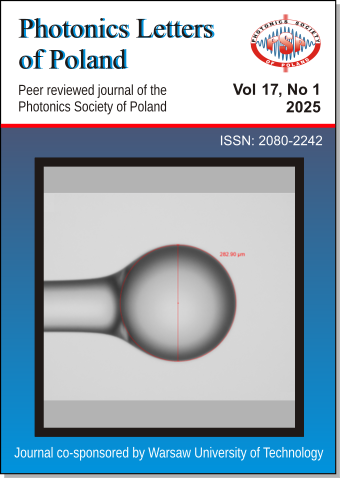Luminescent Monitoring of Eu³⁺-Doped 13-93 Bioactive Glass Fiber Degradation
DOI:
https://doi.org/10.4302/plp.v17i1.1314Abstract
Bioactive 13-93 glass fibers were doped with 0.2 and 2% mol of Eu3+ ions, and drawn using a traditional method. The study examined the degradation rate using the proposed optical method and to analyze the influence of the dopant on the degradation process. The fibers were immersed in SBF for 48 hours, with simultaneous and continuous measurement of the change in the luminescence spectrum (λexc.= 394 nm) at 611 nm. The morphology of the fibers was also investigated. Optical time constant analysis demonstrated that bioactive glass fibers doped with 2% moles of Eu3+ decomposed more slowly than 13-93_02Eu.
Full Text: PDF
References
- L.L. Hench, R.J. Splinter, W.C. Allen, and T.K. Greenlee, "Bonding mechanisms at the interface of ceramic prosthetic materials," J. Biomed. Mater. Res., 5(6), 117 (1971). CrossRef
- M. Brink, T. Turunen, R.-P. Happonen, and A. Yli-Urpo, "Compositional dependence of bioactivity of glasses in the system Na2O-K2O-MgO-CaO-B2O3-P2O5-SiO2," J. Biomed. Mater. Res., 37(1), 114 (1997). CrossRef
- Y.-H. Chan et al., "An evaluation of the biocompatibility and osseointegration of novel glass fiber reinforced composite implants: In vitro and in vivo studies," Dent. Mater., 34(3), 470 (2018). CrossRef
- M.T. Souza, S. Tansaz, E.D. Zanotto, and A.R. Boccaccini, "Bioactive Glass Fiber-Reinforced PGS Matrix Composites for Cartilage Regeneration," Materials (Basel)., 10(1) 2017. CrossRef
- C.R. Patra et al., "In vivo toxicity studies of europium hydroxide nanorods in mice," Toxicol. Appl. Pharmacol., 240(1), 88 (2009). CrossRef
- M. Shi et al., "Europium-doped mesoporous silica nanosphere as an immune-modulating osteogenesis/angiogenesis agent," Biomaterials, 144,176 (2017). CrossRef
- C.R. Patra et al., "Pro-angiogenic Properties of Europium(III) Hydroxide Nanorods," Adv. Mater., 20(4), 753 (2008). CrossRef
- A. Baranowska et al., "Luminescence Sensing Method for Degradation Analysis of Bioactive Glass Fibers," Sensors , 21(6) (2021). CrossRef
- T. Kokubo and H. Takadama, "How useful is SBF in predicting in vivo bone bioactivity?," Biomaterials, 27(15), 2907 (2006). CrossRef
Downloads
Published
How to Cite
Issue
Section
License
Copyright (c) 2025 Agata Baranowska, Krzysztof Markowski, Izabela Zgłobicka, Magdalena Łępicka, Piotr Miluski, Marcin Kochanowicz

This work is licensed under a Creative Commons Attribution 4.0 International License.
Authors retain copyright and grant the journal right of first publication with the work simultaneously licensed under a Creative Commons Attribution License that allows others to share the work with an acknowledgement of the work's authorship and initial publication in this journal. Authors are able to enter into separate, additional contractual arrangements for the non-exclusive distribution of the journal's published version of the work (e.g., post it to an institutional repository or publish it in a book), with an acknowledgement of its initial publication in this journal. Authors are permitted and encouraged to post their work online (e.g., in institutional repositories or on their website) prior to and during the submission process, as it can lead to productive exchanges, as well as earlier and greater citation of published work (See The Effect of Open Access).




